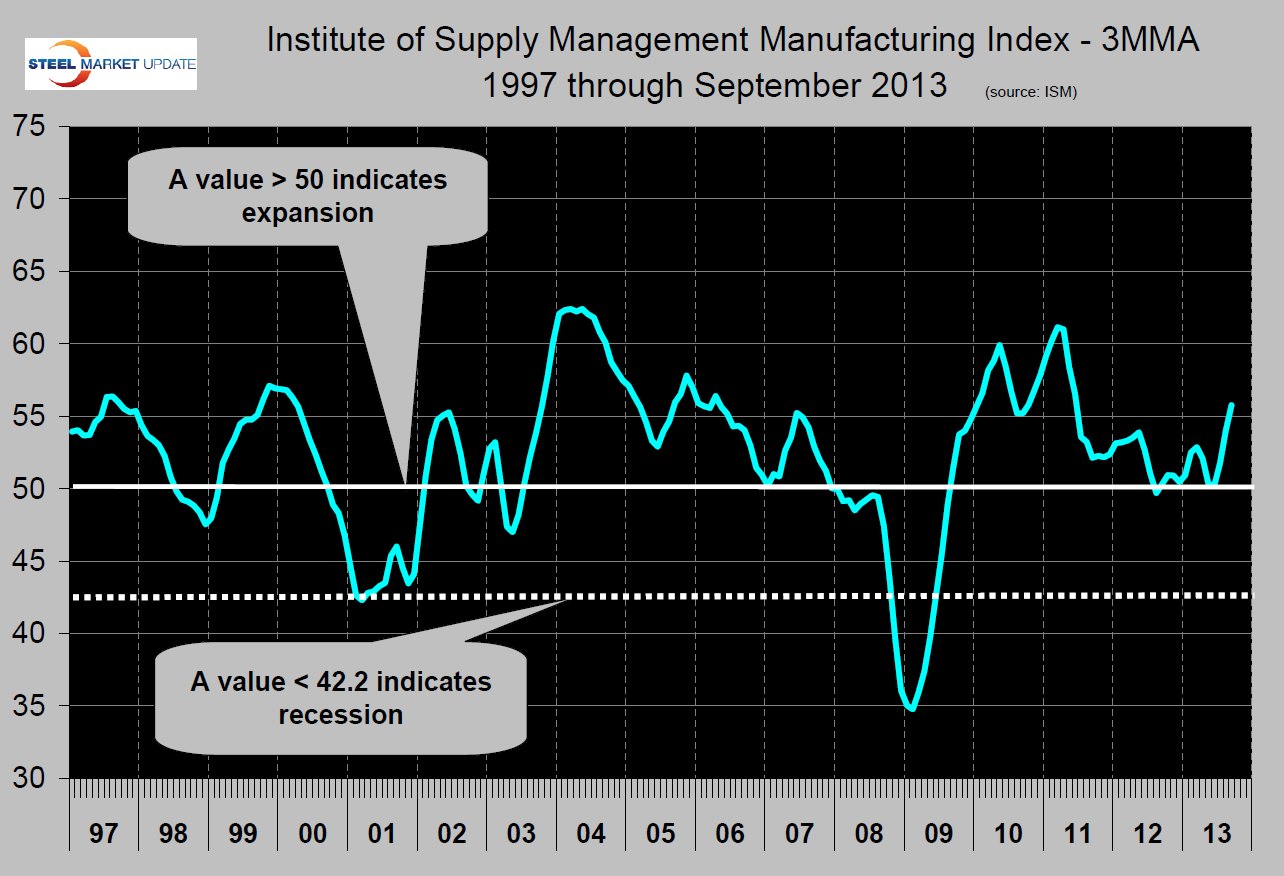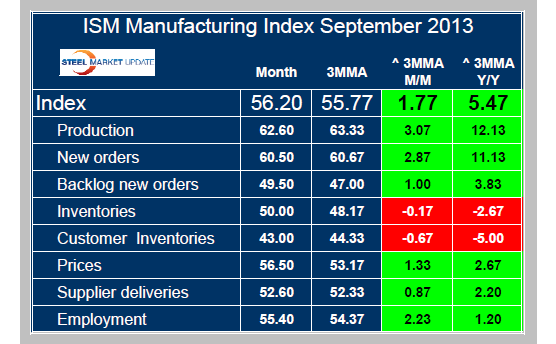Market Data

October 2, 2013
Manufacturing Advanced Again in September
Written by Peter Wright
The Institute of Supply Management Purchasing Managers Index, (PMI) registered 56.2 percent in September, an increase of 0.5 percentage point from the August reading. The 3MMA (three month moving average) of the index was 55.7 in September, the highest in over two years and continued to distance itself from the 50 threshold that marks the boundary between expansion and contraction (Figure 1).
 The New Orders Index decreased in September by 2.7 percentage points to 60.5 percent, and the Production Index increased by 0.2 percentage points to 62.6 percent. The Employment Index registered 55.4 percent; an increase of 2.1 percentage points compared to the August reading of 53.3 percent, and is the highest reading for the year. Comments from the panel were generally positive and optimistic about increasing demand and improving business conditions.
The New Orders Index decreased in September by 2.7 percentage points to 60.5 percent, and the Production Index increased by 0.2 percentage points to 62.6 percent. The Employment Index registered 55.4 percent; an increase of 2.1 percentage points compared to the August reading of 53.3 percent, and is the highest reading for the year. Comments from the panel were generally positive and optimistic about increasing demand and improving business conditions.
Of the 18 manufacturing industries, 11 are reporting growth in September in the following order: Electrical Equipment, Appliances & Components; Food, Beverage & Tobacco Products; Furniture & Related Products; Petroleum & Coal Products; Fabricated Metal Products; Paper Products; Printing & Related Support Activities; Transportation Equipment; Computer & Electronic Products; Machinery; and Plastics & Rubber Products. The six industries reporting contraction in September — listed in order — are: Apparel, Leather & Allied Products; Primary Metals; Textile Mills; Nonmetallic Mineral Products; Miscellaneous Manufacturing; and Chemical Products.”
Moody’s summarized as follows in Economy.com: “The ISM manufacturing survey was surprisingly strong in September. Manufacturing has decent momentum heading into the fourth quarter but this could be sapped quickly by a prolonged government shutdown and heighten policy uncertainty. We had expected the drag from fiscal policy to ease this quarter but this could not come to fruition. Heighten policy uncertainty could weigh on manufacturers hiring and investment plans. The next few weeks will be telling. A government shutdown lasting a week will shave a couple tenths of a percentage point off fourth quarter GDP but the costs quickly escalate. Also, the government shutdown could weigh heavily on manufacturer confidence.”
SMU Comment:The September report is more good news for manufacturing which accounts for over half of total steel consumption in the US. This month we expanded the detail of our analysis shown in the Table below and included a historical review of prices and customer inventories. We believe the negative trend in both manufacturer’s and customer’s inventories is further evidence of our contention that steel demand has been depressed by political uncertainty since December last year and that ultimately we will enjoy a catch up phase as inventories are replenished. This could take many industry players by surprise, assuming of course that congress gets its act together and recognizes the negative effect of their gridlock on American businesses.

Explanation: The Manufacturing ISM Report On Business is published monthly by the Institute for Supply Management, the first supply institute in the world. Founded in 1915, ISM exists to lead and serve the supply management profession and is a highly influential and respected association in the global marketplace. ISM’s mission is to enhance the value and performance of procurement and supply chain management practitioners and their organizations worldwide. This report has been issued by the association since 1931, except for a four-year interruption during World War II. The report is based on data compiled from purchasing and supply executives nationwide. Membership of the Manufacturing Business Survey Committee is diversified by NAICS, based on each industry’s contribution to gross domestic product (GDP). The PMI is a diffusion index. Diffusion indexes have the properties of leading indicators and are convenient summary measures showing the prevailing direction of change and the scope of change. A PMI reading above 50 percent indicates that the manufacturing economy is generally expanding; below 50 percent indicates that it is generally declining. A PMI in excess of 42.2 percent, over a period of time, indicates that the overall economy, or gross domestic product (GDP), is generally expanding; below 42.2 percent, it is generally declining. The distance from 50 percent or 42.2 percent is indicative of the strength of the expansion or decline. With some of the indicators within this report, ISM has indicated the departure point between expansion and decline of comparable government series, as determined by regression analysis.







